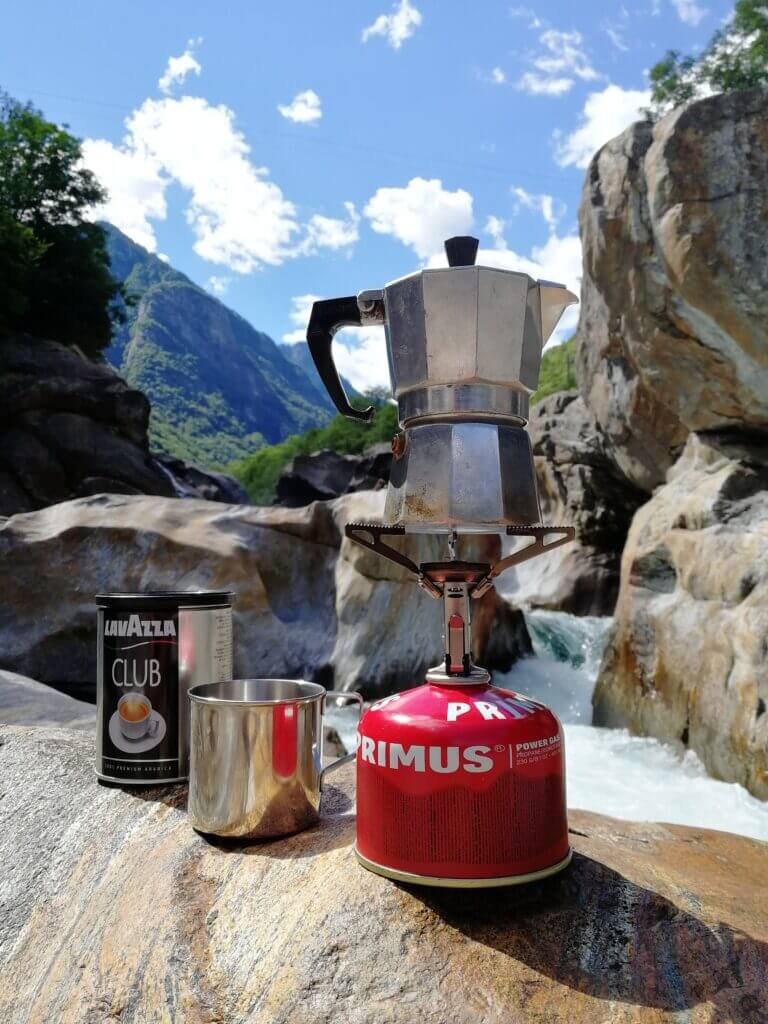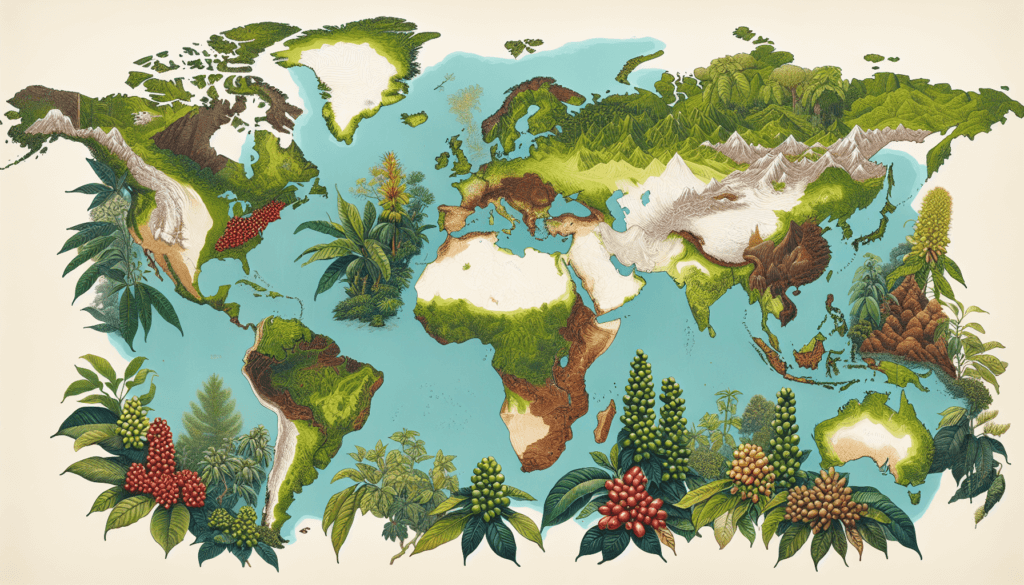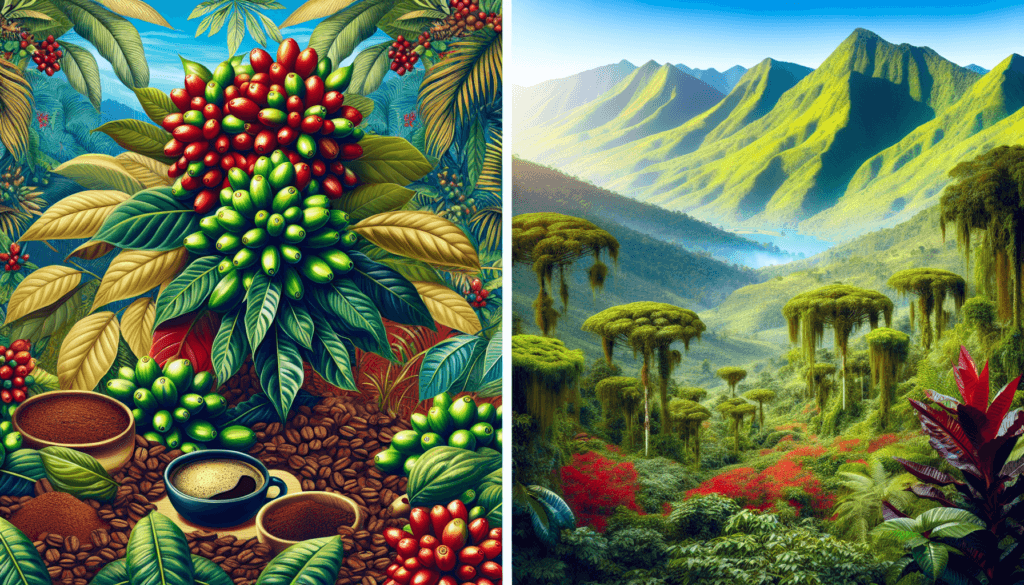Imagine waking up to the rich aroma of a freshly brewed cup of coffee, its bold and smooth flavor tantalizing your taste buds. But have you ever wondered where this beloved beverage comes from? In this article, we will explore the fascinating world of coffee species and uncover their origins. From the lush farms of Ethiopia to the high altitudes of Colombia, join us on a journey to discover where the most coffee species are found. So grab a cup of your favorite brew and get ready to embark on a caffeine-infused adventure. It’s time to delve into the diverse landscapes that nurture this beloved beverage.

Types of Coffee Species
When it comes to coffee, you may be familiar with the popular Arabica and Robusta variations, but did you know that there are actually four main coffee species? These species differ in terms of flavor, aroma, and even growing conditions. Let’s explore each type of coffee species to better understand the diversity that exists within the coffee world.
Arabica
Arabica coffee is the most commonly consumed and widely recognized coffee species. It accounts for more than 60% of the world’s coffee production. Renowned for its delicate flavors and aromas, Arabica beans often exhibit notes of chocolate, fruit, and floral undertones. They are generally grown at higher altitudes, where the cooler temperatures and nutrient-rich soil contribute to their refined taste.
Robusta
While Arabica may steal the spotlight, Robusta coffee holds its own due to its higher caffeine content and distinct flavor profile. Robusta beans tend to have a stronger and more bitter taste compared to Arabica, making them an excellent choice for espresso blends and instant coffee. This species is more resilient and disease-resistant, thriving in lower altitudes and warmer climates.
Liberica
Liberica coffee is less common and represents only a small fraction of the coffee market. It is known for its large, irregularly shaped beans and unique flavor profile, which can be described as woody and floral with a hint of fruitiness. Liberica is primarily grown in the Philippines and is gaining recognition among specialty coffee enthusiasts for its originality.
Excelsa
Excelsa coffee, also found in the same species group as Liberica, is an intriguing and unique coffee variety. Its flavors are often described as fruity, with notes of tartness and hints of dark chocolate. Excelsa is less common than Arabica and Robusta, and its cultivation is primarily concentrated in Southeast Asia.
Regions with the Highest Coffee Species Diversity
Coffee is grown in numerous countries around the world, but some regions stand out for their incredible diversity of coffee species. These regions have a combination of favorable climate, altitude, and soil conditions that allow different coffee species to flourish. Let’s explore the regions with the highest coffee species diversity.
Ethiopia
Ethiopia, often hailed as the birthplace of coffee, boasts an impressive array of coffee species. It is home to diverse varieties such as Sidamo, Yirgacheffe, and Harrar. Each region within Ethiopia has its own unique flavor profiles, influenced by the microclimates, soil types, and traditional processing methods employed by local farmers. Ethiopian coffee is highly regarded for its floral and fruity notes, making it a favorite among coffee enthusiasts.
Colombia
Colombia, renowned for its high-quality coffee, is another region blessed with an abundance of coffee species. The International Coffee Organization recognizes two specific types of Colombian coffee: Excelso and Supremo. These classifications denote the size of the beans, with Supremo being the larger size. Colombian coffee is celebrated for its well-balanced flavors, featuring notes of caramel, citrus, and nuts.
Brazil
As the world’s largest coffee producer, Brazil naturally has a rich coffee species diversity. Some notable Brazilian coffee species include Bourbon, Catuai, and Mundo Novo. These varieties thrive in the vast plantations spread across the country’s diverse microclimates. Brazilian coffee is known for its nutty, chocolatey, and mild flavors, making it suitable for a wide range of palates.
Vietnam
Vietnam may not immediately come to mind when discussing coffee origins, but it has a significant presence in the coffee industry. Vietnam predominantly cultivates Robusta coffee, which is favored for its high caffeine content and robust flavor. This species thrives in the country’s humid climate and contributes to Vietnam’s substantial coffee production.

Coffee Species in Ethiopia
Ethiopia, being the birthplace of coffee, has a deep-rooted coffee culture and is home to several unique coffee species. Let’s delve into some of the coffee species found in Ethiopia and uncover their distinctive characteristics.
Sidamo
Sidamo coffee is grown in the southern part of Ethiopia, predominantly in the Sidama Zone. These beans are known for their medium acidity, full body, and vibrant flavors. Sidamo coffee often exhibits floral and fruity notes, with hints of wine-like undertones. It is coveted for its complexity and is a favorite choice among specialty coffee enthusiasts.
Yirgacheffe
Yirgacheffe coffee, named after the region in southern Ethiopia where it is grown, is highly regarded for its exceptional quality. Yirgacheffe beans are characterized by their floral and citrusy flavors, with a distinct sweetness that sets them apart. They are usually wet-processed, allowing their unique flavors to shine through. Yirgacheffe coffee is often considered one of the finest in the world.
Harrar
Harrar coffee, grown in the eastern part of Ethiopia, is renowned for its wild and distinctive flavors. These beans are processed naturally, allowing the coffee cherries to dry with the fruit pulp intact, infusing the beans with unique fruity and wine-like flavors. Harrar coffee typically has a medium body and acidity, with complex taste profiles that include notes of blueberry, chocolate, and spice.
Coffee Species in Colombia
Colombia is synonymous with high-quality coffee, and its range of coffee species contributes to its reputation as a coffee powerhouse. Let’s explore some of the coffee species found in Colombia, each bringing its own distinct qualities to the table.
Excelso
Excelso coffee is a classification given to medium-sized Colombian coffee beans. It represents the size of the beans and serves as an indicator of quality as well. Excelso coffee is known for its well-balanced flavors, with notes of caramel, dark chocolate, and citrus. Its versatility makes it suitable for various brewing methods, from pour-over to espresso.
Supremo
Supremo coffee, distinguished by its larger bean size, represents the highest grade of Colombian coffee. These beans tend to have a milder acidity and a fuller body compared to Excelso-grade coffee. Supremo coffee often displays a delicate sweetness with hints of nuts, accompanied by citrus or berry undertones.

Coffee Species in Brazil
As the largest coffee producer in the world, Brazil is a coffee lover’s paradise. With its diverse microclimates, Brazilian coffee offers a wide range of flavors and profiles. Here are a few coffee species that thrive in this vibrant country.
Bourbon
Bourbon coffee, originating from the Bourbon Island (now known as Réunion Island), has found a flourishing home in Brazil. Known for its sweet and smooth taste, Bourbon coffee offers a complex flavor profile with notes of caramel, dark chocolate, and even fruity undertones. Brazilian Bourbon coffee is distinguished by its remarkable balance and is often sought after by those who appreciate a refined cup of joe.
Catuai
Catuai coffee is a hybrid variety resulting from a cross between Mundo Novo and Caturra, both of which are widely grown in Brazil. This hybridization has led to a coffee species that combines the desirable traits of both parents. Catuai coffee is characterized by its bright acidity, medium body, and pronounced sweetness. It often delivers flavors of chocolate, fruit, and nuts, making it a popular choice among coffee enthusiasts.
Mundo Novo
Mundo Novo, a cross between Typica and Bourbon coffee, is a prominent coffee species in Brazil. This hybrid variety was developed for its disease resistance and high productivity. Mundo Novo coffee is known for its balanced flavors, with notes of chocolate, nuts, and caramel. Its full-bodied nature makes it suitable for blending and espresso-based beverages.
Coffee Species in Vietnam
Vietnam, a rising star in the coffee industry, is primarily known for its robust Robusta coffee. While Robusta may not enjoy the same prestige as Arabica, it has its own distinct characteristics and is highly sought after for different purposes.
Robusta
Vietnam is one of the largest producers of Robusta coffee globally. Robusta beans cultivated in Vietnam often possess a bold and full-bodied flavor with strong earthy and nutty undertones. The higher caffeine content of Robusta, combined with its relatively lower cost, makes it a desirable choice for those seeking a robust and energetic cup of coffee. Robusta coffee is commonly used in espresso blends and instant coffee.

Coffee Species in Other Regions
While Arabica and Robusta dominate the global coffee market, there are several other countries that produce unique coffee species. Although these regions may not have the same level of diversity as Ethiopia or Colombia, they contribute to the rich tapestry of coffee around the world. Here are a few notable coffee species from other regions.
India
India boasts a range of coffee species, including its renowned Arabica and Robusta coffee. Indian Arabica coffee is known for its medium to low acidity and delicate flavors, often featuring hints of spice and chocolate. Indian Robusta, on the other hand, is robust and full-bodied, with earthy and woody notes. These coffee species often find their place in specialty blends and are highly regarded within the Indian coffee industry.
Indonesia
Indonesia, with its unique geography and rich volcanic soil, produces distinctive coffee varieties. Some well-known Indonesian coffee species include Sumatra Mandheling and Java. Sumatra Mandheling features a heavy body and low acidity, with flavors of dark chocolate and earthy spiciness. Java coffee, which originated on the island of Java, offers a smooth and full-bodied profile with hints of nuts and spices. Indonesian coffee species are renowned for their richness and complexity.
Costa Rica
Costa Rica is celebrated for its specialty coffee production, and it has its own selection of coffee species to boast about. Costa Rican coffee is mainly composed of Arabica varieties, including Caturra, Typica, and Villalobos. Each variety contributes to the diverse flavor profiles found in Costa Rican coffee. Costa Rican Arabica beans often display bright acidity, medium body, and well-balanced flavors, featuring notes of citrus, honey, and tropical fruits.
Mexico
Mexico may be famous for its tequila, but its coffee industry should not be overlooked. Mexican coffee species, primarily composed of Arabica varieties, deliver a range of flavors that reflect the country’s diverse coffee-growing regions. Mexican coffee is known for its medium body, mild acidity, and delicate sweetness. Flavors often include nutty undertones, chocolate hints, and occasionally fruity notes. Mexican coffee is gaining recognition for its quality and is becoming a favorite among specialty coffee enthusiasts.
Factors Affecting Coffee Species Distribution
The distribution of coffee species across different regions is not haphazard; it is influenced by various factors that impact the growth and cultivation of coffee. These factors contribute to the unique characteristics exhibited by coffee species in different parts of the world. Let’s explore the primary factors that affect coffee species distribution.
Climate
Climate plays a crucial role in determining which coffee species can thrive in a particular region. Arabica coffee, for example, requires a moderate climate with relatively cool temperatures. It flourishes at higher altitudes, where the cooler climate helps develop its delicate flavors. In contrast, Robusta coffee is more tolerant of warmer temperatures and can survive in lower altitudes with less rainfall.
Altitude
Altitude is another significant factor that affects coffee species distribution. Different coffee species have different altitude preferences, and their flavors can be influenced by the altitude at which they are grown. Arabica coffee, for instance, generally thrives at higher altitudes (around 2,000 to 6,000 feet above sea level) where the temperature, humidity, and soil conditions are ideal for its growth. In contrast, Robusta coffee can be grown at lower altitudes, typically between 600 to 2,000 feet, where it adapts to warmer temperatures and exhibits its characteristic flavors.
Soil Conditions
Soil conditions have a profound impact on the growth and characteristics of coffee species. Factors such as nutrient availability, pH levels, and mineral content in the soil influence the flavor profiles of coffee beans. Arabica coffee, for instance, prefers well-drained and slightly acidic soil. This type of soil contributes to the development of the nuanced flavors and aromas that Arabica is known for. Robusta coffee, on the other hand, is more adaptable and can tolerate a wider range of soil conditions.
Cultivation Practices
Cultivation practices employed by coffee farmers also influence the distribution of coffee species. The methods used for planting, pruning, harvesting, and processing can significantly impact the final product. For example, the traditional wet-processing method used in Ethiopia enhances the unique flavors of the coffee beans, resulting in the distinct fruity and floral notes found in Ethiopian coffees. Differences in cultivation practices can help preserve the authentic flavors of coffee species in specific regions.

Impact of Coffee Species Diversity
The diversity of coffee species has profound implications for the coffee industry and enthusiasts around the world. This diversity touches upon various aspects, including flavor profiles, market demand, and crop resilience. Let’s explore the impact of coffee species diversity in more detail.
Flavor Profiles
One of the most exciting aspects of coffee species diversity is the wide range of flavor profiles it offers. Each coffee species brings its own unique set of flavors, aromas, and complexities to the table. From the delicate floral notes of Arabica to the robust and earthy flavors of Robusta, coffee enthusiasts have a diverse array of tastes to explore and indulge in. This diversity allows coffee connoisseurs to experience an ever-evolving world of flavors and ensures that there is a coffee species to suit every palate.
Market Demand
The market demand for different coffee species is influenced by consumer preferences, cultural traditions, and global trends. Arabica coffee, with its delicate flavors and wide popularity, generally enjoys higher demand. It is often associated with specialty coffee and commands a higher price in the market. Robusta coffee, on the other hand, is in demand for its use in blends, instant coffee, and espresso. The market demand for specific coffee species contributes to economic growth, employment opportunities, and trade within coffee-producing regions.
Crop Resilience
Coffee species diversity plays a crucial role in ensuring the resilience of coffee crops against pests, diseases, and climatic variations. By cultivating a range of coffee species, farmers reduce the risk of complete crop failure or significant losses due to external factors. For example, Robusta coffee, known for its resistance to diseases and ability to thrive in lower altitudes, provides an alternative for farmers in regions where Arabica may be vulnerable to pests or diseases. This crop resilience helps maintain consistent coffee production and safeguards the livelihoods of coffee farmers worldwide.
Conservation of Coffee Species
The conservation of coffee species is becoming increasingly important as threats such as climate change, deforestation, and monoculture practices pose risks to coffee biodiversity. Conservation efforts aim to protect and preserve the genetic diversity found within different coffee species. Let’s explore the challenges faced in coffee species conservation and some initiatives that are working towards safeguarding these precious resources.
Challenges
Conserving coffee species faces several challenges, including habitat loss, climate change, genetic erosion, and limited funding for research and conservation activities. The expansion of agriculture and deforestation lead to the destruction of natural habitats where coffee species thrive. Climate change brings about unpredictable weather patterns, disrupting the growth and cultivation of coffee. Furthermore, the focus on high-yielding and disease-resistant varieties can lead to the neglect and gradual extinction of traditional and lesser-known coffee species.
Initiatives
To address these challenges, various initiatives and organizations are working towards the conservation of coffee species. One such initiative is the establishment of protected areas for coffee forests, allowing for the preservation of natural habitats and diverse ecosystems. These protected areas not only protect coffee species but also support other crucial flora and fauna. Additionally, organizations are involved in research and development efforts to understand the genetic makeup of coffee species and identify traits that contribute to adaptation and resilience. This knowledge can help breed new varieties and preserve the unique characteristics of existing coffee species.
Furthermore, collaborations between coffee farmers, researchers, and conservation organizations promote sustainable farming practices that protect biodiversity. Through education and awareness programs, farmers are empowered to adopt environmentally friendly practices that promote the conservation of coffee species. Additionally, certifications such as Rainforest Alliance and Fairtrade ensure that coffee production follows strict environmental and social standards, contributing to the conservation of coffee species and promoting sustainable livelihoods for farmers.
In conclusion, coffee species diversity is a fascinating aspect of the coffee world, showcasing the intricate flavors, aromas, and characteristics that make each cup of coffee unique. From the delicate nuances of Arabica to the boldness of Robusta, coffee enthusiasts have the opportunity to explore a diverse range of flavors and indulge in their favorite brews. The cultivation of different coffee species in various regions contributes to the economic growth of coffee-producing nations and sustains the livelihoods of farmers. However, it is crucial to recognize the importance of coffee species conservation, as threats to biodiversity increase. By preserving and protecting coffee species, we ensure that future generations can continue to enjoy the rich flavors and cultural heritage that coffee provides.


